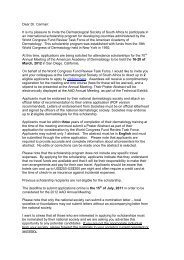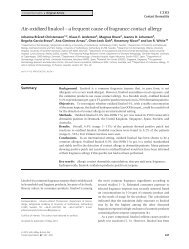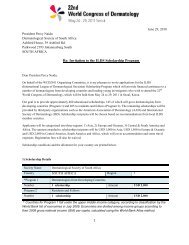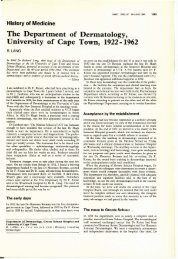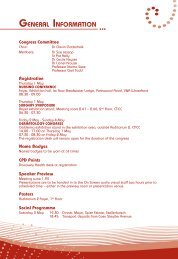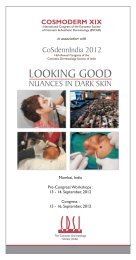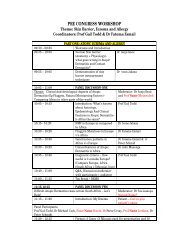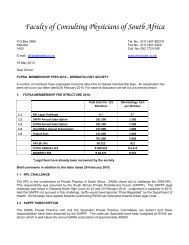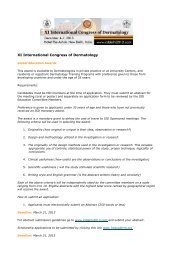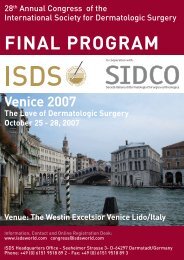Guidelines on the Management of Atopic Dermatitis ... - Dermatology
Guidelines on the Management of Atopic Dermatitis ... - Dermatology
Guidelines on the Management of Atopic Dermatitis ... - Dermatology
Create successful ePaper yourself
Turn your PDF publications into a flip-book with our unique Google optimized e-Paper software.
interventi<strong>on</strong>s can be attempted. Only <strong>the</strong> evidence for a role <strong>of</strong> allergen avoidance in<br />
established atopic dermatitis will be addressed here.<br />
A. Inhalant allergy<br />
House dust mite [1+; B]<br />
Circumstantial evidence suggests an important precipitating role for house dust mite<br />
allergens in patients with atopic dermatitis. Reducing exposure to <strong>the</strong> allergen should<br />
<strong>the</strong>oretically be beneficial for cases <strong>of</strong> established dermatitis.<br />
A review <strong>of</strong> <strong>the</strong> evidence for house dust mite reducti<strong>on</strong> revealed that <strong>the</strong>re is little evidence<br />
to support a clinical benefit from house dust mite allergen reducti<strong>on</strong> in preventing atopic<br />
dermatitis or c<strong>on</strong>trolling established disease, although it may help to reduce severity in<br />
severe atopic dermatitis. 5,10<br />
Pollens [1-; C]<br />
Seas<strong>on</strong>al variati<strong>on</strong>s in atopic dermatitis could be related to exposure to pollens. 9<br />
Animals [1+; B]<br />
There is currently c<strong>on</strong>flicting evidence for <strong>the</strong> role <strong>of</strong> pet allergens in atopic dermatitis. 9,24,25,26<br />
In a systematic review <strong>of</strong> cohort, case-c<strong>on</strong>trolled and cross-secti<strong>on</strong>al studies, Langan et al<br />
found no good evidence for a protective effect <strong>of</strong> furry pet avoidance. 33 In African studies <strong>of</strong><br />
atopic dermatitis <strong>the</strong>re is no associati<strong>on</strong> with animals in <strong>the</strong> home and atopic dermatitis. 27-30<br />
B. Ingestant allergy [1+; B]<br />
Diet manipulati<strong>on</strong> o<strong>the</strong>r than food avoidance:<br />
Diet supplementati<strong>on</strong> with a variety <strong>of</strong> products has been suggested both for preventi<strong>on</strong> <strong>of</strong><br />
atopic dermatitis (maternal manipulati<strong>on</strong>) and c<strong>on</strong>trol <strong>of</strong> existing disease. These aspects are<br />
dealt with fully under <strong>the</strong> secti<strong>on</strong> c<strong>on</strong>cerning food allergies and <strong>the</strong> secti<strong>on</strong> <strong>on</strong> preventi<strong>on</strong> <strong>of</strong><br />
atopic dermatitis.<br />
C. C<strong>on</strong>tact allergy [1-; C]<br />
Increasing evidence is being found for <strong>the</strong> role <strong>of</strong> c<strong>on</strong>tact allergens in atopic patients. It is<br />
well known that atopic dermatitis is a risk factor for developing c<strong>on</strong>tact allergies, but <strong>the</strong><br />
precise role <strong>of</strong> c<strong>on</strong>tact reacti<strong>on</strong>s (irritant and allergic) in atopic dermatitis pathogenesis is not<br />
clear. 9<br />
In a prospective subgroup analysis <strong>of</strong> 143 Polish children and adolescents classified as<br />
having atopic dermatitis by <strong>the</strong> ISAAC criteria, <strong>the</strong> authors found c<strong>on</strong>siderable overlap<br />
between atopic and allergic c<strong>on</strong>tact dermatitis (55.4% and 30% in children and 38.6% and<br />
51.7% in adolescents respectively). Of those diagnosed with atopic dermatitis based <strong>on</strong> a<br />
history <strong>of</strong> an itchy flexural rash, 19.5% (9/46) children and 52% (13/25) adolescent were<br />
found to be due to allergic c<strong>on</strong>tact dermatitis and lacked sufficient features for a diagnosis <strong>of</strong><br />
atopic dermatitis by Hanifin and Rajka‟s criteria. 31<br />
A systematic review and meta-analysis <strong>of</strong> allergens resp<strong>on</strong>sible for allergic c<strong>on</strong>tact<br />
dermatitis found that <strong>the</strong> top five allergens in children and adolescents included nickel,<br />
amm<strong>on</strong>ium persulfate, gold sodium thiosulfate, thimerosal and p-toluenediamine. 32 Most<br />
studies were from Europe and <strong>the</strong> United States and <strong>the</strong> proporti<strong>on</strong> <strong>of</strong> positive reacti<strong>on</strong>s<br />
increased from 1995.



